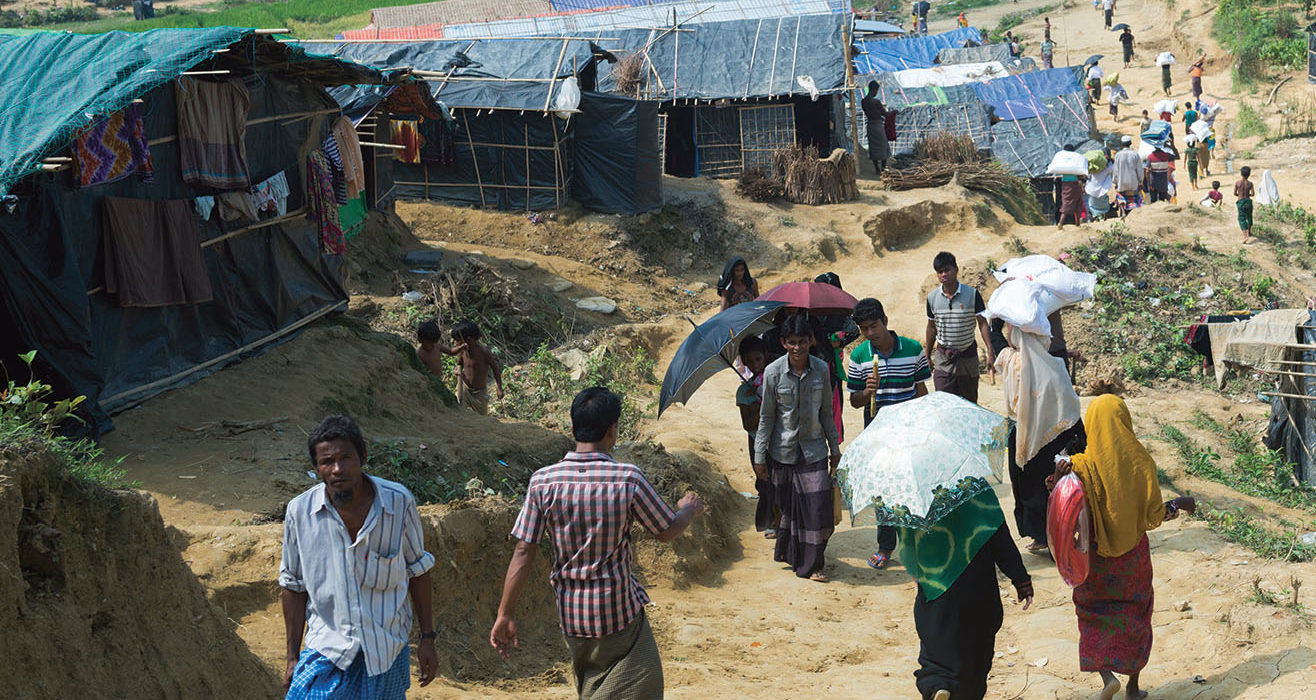Disasters may involve human negligence or be a by-product of human actions, but in general are not the primary intended consequence of human actions. Although similar in some ways, disastrous events that result from intentional human action (e.g. terrorism and mass shootings) generally fall into a separate category from disasters. Here are some resources for helping the recovery from disasters, both natural and of human creation, that have generated the greatest need in recent years.
Natural Disasters
Michael and Florence (2018)
Hurricane Michael struck the Florida panhandle in October 2018 as the fourth most powerful storm ever to hit the U.S. Michael caused widespread destruction in several coastal communities, and caused tornadoes in Georgia and flooding throughout North Carolina and Virginia. Michael’s flooding added to significant damage previously caused by Hurricane Florence, which brought record flooding throughout the Carolinas in September.
Dozens of people died in both storms and their aftermath. While many people lost homes, others such as migrant farm workers lost livelihoods as agricultural crops were destroyed. Many organizations that mobilized in advance of Florence have extended operations further south to also address the needs of victims of Michael. Organizations well-positioned to help include:
- Americares and Direct Both were on the ground in North Carolina before Hurricane Florence arrived, and have been providing emergency medicines and relief supplies to families displaced by both hurricanes.
- Mercy It has helped to address immediate needs through a partnership with Team Rubicon. The groups plan to utilize emergency cash assistance to the most affected and vulnerable communi- ties, giving storm survivors the opportu- nity to purchase whatever supplies they need for recovery.
- Episcopal Relief & Development. It works with local partners to support sea- sonal farmworkers in rural areas, providing items such as water, food, cleaning supplies, clothing, and transportation to safe
- Local and State Community Foundations (all with disaster relief funds established for longer term recovery). Examples include: the Central Carolina Community Foundation, Foundation for the Carolinas, North Carolina Community Foundation, and the Florida Disaster Fund of the Volunteer Florida Foundation.
Harvey, Irma, Maria (2017)
A staggering 25.8 million people were affected by Hurricanes Harvey, Irma, and Maria in 2017. Some 4.7 million people registered for federal assistance from FEMA, more than all who registered after Hurricanes Katrina, Rita, Wilma, and Sandy combined. Housing, access to healthcare, and food insecurity continue to be critical concerns, particularly for members of storm-affected communities who were vulnerable even before the hurricanes. For example, only about half of applicants in Puerto Rico received any government housing assistance due to a lack of official property records as required by FEMA. Organizations working on these issues include:
- All Hands and Hearts. This nonprofit mobilizes volunteers to work on rebuilding schools, homes and other infrastructure projects along with communities affected by major disasters around the The organization develops partnerships with local groups, with goals of building long term resiliency as well as improving local capacity to handle future responses. For example, a partnership with My Brother’s Workshop on St. Thomas helps provide construction job training and experience for local youth.
- Local community foundations and funds. Examples include the Community Foundation of the U.S. Virgin Islands, the Hurricane Harvey Relief fund at the Greater Houston Community Foundation, and the Puerto Rico Real Time Recovery Fund managed by the nonprofit ConPRmetidos.
- Local Food Feeding America connects surplus food to local food banks and pantries around the U.S., including the U.S. Virgin Islands and Puerto Rico. Donors can give nationally or locally to specific food banks in hurricane affected communities.
Man-made Disasters and Refugees
Worldwide, more than 68 million people have been displaced from their homes. Of these, over 25 million are considered refugees: people who left their own countries due to violence or a well-founded fear of persecution. Half of these are children.
Some crises are relatively recent: For example, tensions between the Myanmar government and the Rohingya ethnic minority flared into widespread government-sponsored violence in 2016. Since then, nearly 900,000 Rohingya have fled to neighboring Bangladesh, gathering in what is now the largest refugee camp in the world. The civil war in Yemen has been intensifying since 2015, with horrifying consequences for the civilian population. Other conflicts, such as those in Syria and Sudan, have lasted much longer.
The Center for Disaster Philanthropy estimates that 48% of disaster philanthropy goes to natural disasters, yet only 17% goes to man-made ones despite more people being affected by such humanitarian crises. Donors can help make up this difference by supporting organizations providing urgent, humanitarian aid, as well as those helping refugees and displaced persons increase their self-sufficiency and long-term stability, including resettlement. Below is a sample of organizations involved in this work:
- UNICEF – USA provides immunizations, clean water, food, education, child pro- tection, safe spaces, and post-trauma mental health care services to vulnerable children around the world/
- International Rescue Committee supports refugees and victims of man- made/humanitarian crises. It provides emergency supplies and medical care, education for children, skill training for employment, and resettlement
- Save the Children supports children and their families by providing clean water, therapeutic feeding for malnutrition, ac- cess to health care services, cash vouch- ers for food support, and safe spaces for children to learn.
- International Refugee Assistance Proj- ect (IRAP) offers free legal aid to refugees who wish to resettle from their countries of first IRAP also litigates for refugee rights in local court systems, and leverages its grassroots network to identify and assist most at-risk refugees, such as female survivors of sexual or gender-based violence, children with medical emergencies, and persecuted religious minorities.
Additional Guidance from CHIP
Four Things You Can do to Support Refugees
Family Separation Crisis on the U.S. Border: How Donors Can Help.

